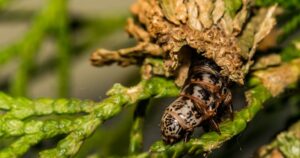If you see these hanging from your tree, you need to know what it means
Bagworms are members of the superfamily Tineoidea, which is a Ditrysia basal lineage (as is Gelechioidea, which includes case-bearers). The family is rather tiny, with approximately 1,350 species found practically everywhere.
Despite their name, which stems from the worm-like larvae, these insects are moths, not worms.
Bagworms spend their whole life cycle within their bag, which they build out of silk and interwoven fragments of vegetation. These bags are formed when larvae attach bits of plant waste to their bodies, such as leaves, twigs, and bark, with a silk-like thread they manufacture. As they increase in size, so does the sack.

Female moth eggs hatch in late spring or early summer.
Only the mature male moth leaves the safety of its bag to mate, but the female moth does not.
Bagworms typically infest evergreen and deciduous trees, and the bags they build can mimic a cone, so they may go unnoticed at first.
Bagworm prefers cedar, arborvitae, juniper, and false cypress as hosts, but in the absence of these, bagworm will devour the foliage of almost any tree: fir, spruce, pine, hemlock, sweetgum, sycamore, honey locust, and black locust.
Bagworms, despite their appearance, cause significant damage to trees. The problem is that they remain hidden until the infection becomes serious.
They make it more difficult for the tree to photosynthesize and produce the nutrients required for growth and survival by feeding on the tree’s leaves.
At the same time, they weaken the tree, making it more susceptible to diseases, pest infestations, and environmental stressors. The tree may die if it is not treated for bagworms.
Bagworm infestations can be managed in a variety of methods. Some of these are discussed more below.
One method is to take each bag/cocoon out of the tree one at a time. This is conceivable if the number of trees damaged is low. This is not the best strategy for dealing with a landscape of damaged trees, each of which contains multiple bags of bagworms.
Fortunately, various options exist, such as: Pruning and Destruction – In the event of widespread infection, prune the damaged branches and properly destroy them. Look for more infestations, such as neighboring fences.
Encourage Natural Predators – Because some birds and parasitic wasps feed on bagworms, enticing them can be beneficial when fighting bagworms. Woodpeckers, for example, can rip open the bags and eat the females or eggs within. Encouraging this strategy by making your yard or farm bird-friendly aids in avoiding the need of insecticides, which would otherwise kill beneficial insects.

Chemical Control – If nothing else works, consider using sprays of acephate (Orthene), cyfluthrin, and spinosad. It is critical to remember that chemical control should be treated with prudence and utilized only as a last resort, given the potential environmental damage. If you choose chemical control, make sure to do it on a windless and dry day so the product dries fast and doesn’t blow away in the breeze.
It would be preferable to avoid an infestation of bagworms in the first place. This can be accomplished through regular tree inspection, excellent maintenance, planting trees at appropriate distances to avoid overcrowding, and monitoring the surrounding vegetation, among other things.
Please SHARE this article on Facebook with your family and friends.




